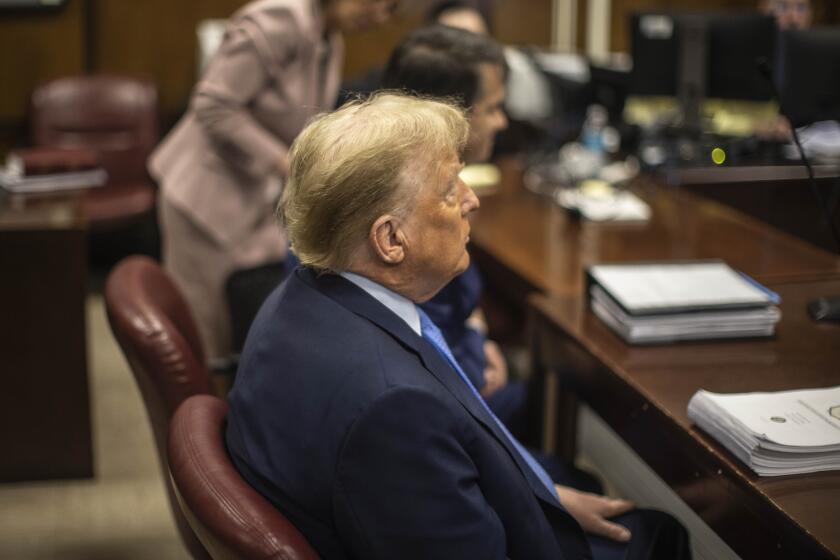Who Cut Deficit by How Much? No One Can Keep Track
At his Oct. 22 press conference, President Reagan squarely blamed Congress for the record federal budget deficits of his Administration. “For six years,” he insisted, “I’ve repeatedly asked for less money and they’ve turned around and given me more to spend.”
At the root of Reagan’s charge are two basic questions: How much deficit reduction has he proposed in his six federal budgets? And how much has Congress actually approved?
Unfortunately, those questions have no easy answers. In fact, nobody--not the President’s Office of Management and Budget, not the Congressional Budget Office, not any of the outside groups that keep track of the budget--has sought to determine how much the President has proposed to reduce deficits and whether Congress has given him more or less than he has asked. The reasons are as complicated as the trillion-dollar budget itself:
--The nature of the budgets.
The President’s annual budget does not list his deficit reduction proposals. And Congress’ disposition of the President’s budget is harder yet to analyze. No single document pulls together the effects of all the spending and tax actions that Congress takes each year.
--The variable base line.
Deficit reduction is measured not against what the deficit was the previous year but against what it would be this year under current policies--the so-called base line.
Defining current policies is tricky. In a period of growth in the defense budget, for example, does current policy mean last year’s program levels or 5% more than last year’s program levels? Yet the size of the base line determines the amount of deficit reduction.
--The whims of the economy.
All estimates of spending and tax revenue are highly sensitive to changes in economic conditions. When the economy falls short of expectations, for example, tax revenue does likewise. Similarly, when inflation exceeds expectations, so does spending for everything from Social Security benefits to nuclear submarines.
The President proposes his budget eight months before the beginning of the fiscal year. Projecting economic conditions that far ahead is a risky proposition at best.
Congress then adopts a budget resolution that is generally based on the same economic assumptions as the President’s budget. For purposes of analyzing their deficit reduction proposals, the two are thus comparable. The trouble is that the congressional budget does no more than guide Congress’ subsequent piecemeal spending and tax bills.
Estimates of the impact of those bills are based on separate economic assumptions; the assumptions that apply to a single bill sometimes change considerably as the bill works its way through the legislative process. In the end, deficits rise or fall because of both policy actions and changes in economic assumptions; separating the economic effects from the policy effects is almost impossible.
--The whims of the weather.
Just as the economy affects tax revenue, so does the weather influence how much money the government pays in its farm subsidy programs. Better weather generally results in more government spending because good weather means bountiful harvests and low market prices. But farm spending can also change as a result of policy actions by the President and Congress.
When spending actually rises or falls--and farm spending has been extremely volatile in recent years--analysts have great difficulty in differentiating between the changes resulting from policy and those resulting from the weather.
--Phony cuts.
Further complicating the situation is that the President and Congress both typically claim unreal deficit reductions. In his first month in office, for example, Reagan’s revision of President Jimmy Carter’s fiscal 1982 budget included $44 billion in domestic savings to be proposed later--but they were never proposed. That same budget was based on an intentionally unrealistic estimate of the economy’s future, which became known as a “rosy scenario.”
Congress can play the same game. Its 1985 deficit reduction package was so full of gimmicks that Sen. Bob Dole (R-Kan.) characterized it as “blue smoke and mirrors.” And last year, when Congress was trying to meet the $154-billion deficit target set by the Gramm-Rudman law for fiscal 1987, it moved a $680-million installment of the federal revenue-sharing program by five days so that it would fall at the end of fiscal 1986 instead of the beginning of fiscal 1987.
--The long run.
Perhaps worst of all, it is impossible for anyone to determine what the long-term impact would have been of proposals that were never implemented. What happens in the first year of a budget is really much less important than how it affects spending and revenues down the road. But, when Congress rejects a Reagan plan to eliminate a domestic program or the White House refuses to go along with a tax increase, nobody can say what might have been and everybody has to start all over again to deal with the new political reality.
The difficulty of analyzing efforts to reduce the deficit has undoubtedly contributed to the failure of Congress and the Administration to accomplish more. When the deficit remains high, the public cannot figure out where the blame belongs.
Certainly the deficit has remained high. As Sen. Bob Packwood of Oregon, the ranking Republican member of the Senate Finance Committee, said during a break in Tuesday’s budget negotiations: “We’ve never faced up to this (deficit problem) before.” When asked whether Congress and the Administration are finally doing it, he replied: “Not so far.”
More to Read
Get the L.A. Times Politics newsletter
Deeply reported insights into legislation, politics and policy from Sacramento, Washington and beyond. In your inbox three times per week.
You may occasionally receive promotional content from the Los Angeles Times.






